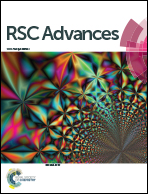Type-I clathrates of K7.69(2)Cu2.94(6)Ge43.06(6) and Rb8Ag2.79(4)Ge43.21(4)†
Abstract
Type-I clathrates of K7.69(2)Cu2.94(6)Ge43.06(6) and Rb8Ag2.79(4)Ge43.21(4) are synthesized directly from the corresponding elements. The structures are resolved by powder XRD data by means of a least-squares technique using WinCSD program. The refined lattice parameters are a = 10.70783(3) Å and a = 10.84493(3) Å for K7.69(2)Cu2.94(6)Ge43.06(6) and Rb8Ag2.79(4)Ge43.21(4), respectively. The electronic band structure and density of states indicate K8Cu3Ge43 and Rb8Ag3Ge43 are p-type semiconductors with narrow indirect band gaps of 0.33 and 0.24 eV. In addition, K7.69(2)Cu2.94(6)Ge43.06(6) displays a diamagnetism with χ = −1.102(1) × 10−3 emu mol−1 in the field of 7 T at 400 K and has a strong Einstein model with θE = 56.3(1) K and θD = 297(3) K.


 Please wait while we load your content...
Please wait while we load your content...